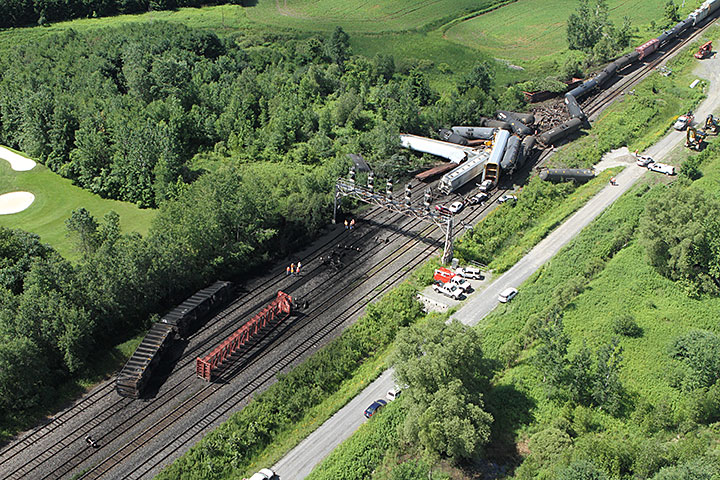Main track derailment
Canadian National Railway
Freight train M-310-31-09
Mile 127.52, Kingston Subdivision
Brockville, Ontario
The occurrence
On , at approximately 0410 Eastern Daylight Time, while proceeding eastward at 60 miles per hour, approaching Brockville, Ontario, Canadian National freight train M-310-31-09 derailed 26 cars at Mile 127.52 on the Kingston Subdivision. The derailed cars included 13 residue tank cars which last contained aviation fuel (UN1863). A small amount of product was released. There were no injuries.
Media materials
News releases
Poor performance of wheel set contributed to July 2014 Canadian National Railway derailment near Brockville, Ontario
Read the news release
Deployment notice
TSB deploys a team of investigators to the site of a derailment involving a CN freight train near Brockville, Ontario
Transportation Safety Board of Canada (TSB) is deploying a team of investigators to the site of a derailment involving a CN freight train which has derailed 26 cars near Brockville, Ontario. The TSB will gather information and assess the occurrence.
Investigation information
Download high-resolution photos from the TSB Flickr page.
Class of investigation
This is a class 3 investigation. These investigations analyze a small number of safety issues, and may result in recommendations. Class 3 investigations are generally completed within 450 days. For more information, see the Policy on Occurrence Classification.
TSB investigation process
There are 3 phases to a TSB investigation
- Field phase: a team of investigators examines the occurrence site and wreckage, interviews witnesses and collects pertinent information.
- Examination and analysis phase: the TSB reviews pertinent records, tests components of the wreckage in the lab, determines the sequence of events and identifies safety deficiencies. When safety deficiencies are suspected or confirmed, the TSB advises the appropriate authority without waiting until publication of the final report.
- Report phase: a confidential draft report is approved by the Board and sent to persons and corporations who are directly concerned by the report. They then have the opportunity to dispute or correct information they believe to be incorrect. The Board considers all representations before approving the final report, which is subsequently released to the public.
For more information, see our Investigation process page.
The TSB is an independent agency that investigates air, marine, pipeline, and rail transportation occurrences. Its sole aim is the advancement of transportation safety. It is not the function of the Board to assign fault or determine civil or criminal liability.

